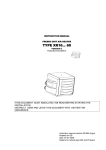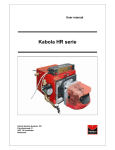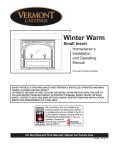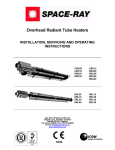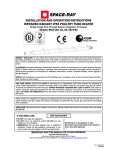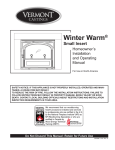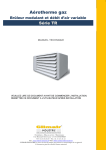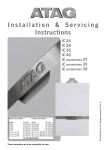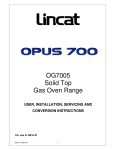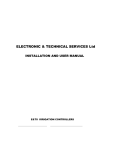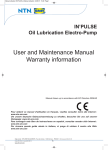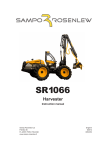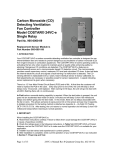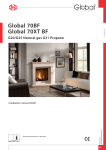Download Installation Guide
Transcript
Production from 2006-09 GB 122i THIS DOCUMENT MUST ABSOLUTELY BE READ BEFORE STARTING THE INSTALLATION. INSTRUCT USER AND LEAVE THIS DOCUMENT WITH THE HEATER FOR REFERENCE. Instruction manual version GB122i Argus Heaters for GB Date: 16-10-2008 Heaters for natural gas G20 and Propane This installation and user manual contains the installation and users instructions for the standard and axial model of the TR-series. For the centrifugal, duct or air curtain models, additional instructions are provided in an appendix. This manual is produced specifically for the gas, electrical and mechanical installer. Also, it contains instructions how to install, use and maintain the heater. To assure a safe and efficient operation of this unit air heater, it is absolutely necessary to apply the instructions in the manual(s) correctly. Page 1 INTRODUCTION: 2 2 CONTENT: 2 3 GENERAL 3 3.1 4 GUARANTEE 3 APPLICATION RESTRICTIONS 4.1 4.2 3 PRE-CHECK PROTECTION DEGREE 3 3 5 TECHNICAL DETAILS: 4 6 INSTALLATION 5 6.1 6.2 6.3 6.4 6.5 6.6 7 POSITIONING POSITIONING THE HEATER GAS CONNECTION ELECTRICAL CONNECTION AIR INTAKE / COMBUSTION PRODUCTS DISCHARGE AIR INTAKE FROM INSIDE B22 5 5 6 6 7 8 FUNCTIONING OF THE UNIT 7.1 7.2 7.3 7.4 7.5 7.6 8 8 GENERAL HEAT DEMAND DELTA-T-REGULATION (TEMPERATURE CONTROLLED DE-STRATIFICATION FAN) SUMMER VENTILATION HIGH LIMIT PROTECTION DESCRIPTION HEATER CONTROL HC 8 9 9 9 9 10 PUTTING INTO OPERATION AND ADJUSTMENT 8.1 8.2 8.3 8.4 9 10 GENERAL START BY USING THE SERVICE-BUTTON START BY USING THE THERMOSTAT TO SIMULATE A LOCK OUT CONDITION 10 11 11 11 ADJUSTING THE GAS-CONTROL 10 10.1 11 11.1 11.2 11.3 12 12.1 12.2 12.3 13 12 PROBLEM SOLVING 12 GENERAL 12 MAINTENANCE / SPARE PARTS 14 GENERAL INSPECTION INSPECTION OF THE HEATER SPARE PARTS 14 14 15 EXAMPLES ELECTRICAL INSTALLATION 15 INSTALLATION WITH MODULATING ROOM THERMOSTAT INSTALLATION OF MORE HEATERS ON ONE THERMOSTAT INSTALLATION WITH ON/OFF THERMOSTAT 15 15 16 ELECTRICAL DIAGRAM Instructions Air heaters type TR (GB 122i) 17 Page 2/17 General The TR unit air heaters are direct fired gas heaters with an output up to 100 kW. The heat exchanger is built with S-shaped tubes, each having its own atmospheric burner. Depending on the power of the heater, there are more burners and tubes in one appliance. Further the heater is provided with a sophisticated control sequence to maintain a comfortable room temperature and even air distribution. It is imperative that the installation and maintenance of this appliance are carried out by qualified gas engineers, and strictly according to our instructions. 2.1 Guarantee The guarantee is invalidated when the air heaters are not installed in accordance with this manual. ! ! Important! The installation and maintenance of this air heater should be performed by an authorised competent installer in accordance with this manual. 3.1 Pre-check Before unpacking and installation, please check (i.e. on the data badge) if the heater corresponds to the order and if it is suitable for the local present provisions (gas type, gas pressure, electrical supply etc.) The installation must comply with all applicable local and national standards. The installation of the air heater must be in accordance with the relevant requirements of the Gas Safety Regulations (for example in GB; The Institute of Gas Engineers IGE UP-1 and 2), Building Regulations and the IIE Regulations also incorporating the gas safety (installation and use) regulations. Other national and/or local regulations may apply (the Local Authority, Fire Officer and Insurers) The competent installer must make sure the heater operates correctly and must instruct the user about the safe operation of the heater. A ventilation gap of 30 cm is required from the top and bottom of the heater to any flammable materials. If this heater is taking its combustion air from within the room in which it is located, the necessary ventilation requirements must be followed for gas safety regulations. The heater should not be installed in areas containing any corrosive or explosive vapours, high moisture or dust concentrations, negative pressures or temperatures higher than 30°C; please consult Winterwarm or your supplier, otherwise the guarantee will become invalidated. Make sure that the warm air can be blown out freely. There should absolutely be no (possibility of) materials within 5m from the front of the heater. The heater has been tested in detail on safety and correct operating settings before leaving the factory. It has been adjusted for the type of gas that is stated on the data badge. Should there be any doubt, please contact your supplier. 3.2 Protection degree The heater has a protection degree of IP20, which means it can be used in a dry and not very dusty environment. This also goes for the Winterwarm room-thermostat. Instructions Air heaters type TR (GB 122i) Page 3/17 " # ! Type Maximum nominal heat input (Nett) Minimum nominal heat input (Nett) Efficiency max power Efficiency min power Maximum heat output Minimum heat output Max air output (+ temp increase) Throw horizontal (max) Throw vertical (max. warm) Sound level Electric Connection Thermostat communication bussystem (low voltage) Power Consumption Power Consumption Amps Gas connection pressure swich point Flue / air connectionvoer parallel Minimum suspension height horizontal throw Minimum suspension height vertical throw kW kW % % kW kW m3/h m m dB(A) Vac TR10 10,8 6,5 91,9 87,9 9,9 5,7 2000 12,0 4,0 42 230 TR15 16,2 9,7 91,6 87,4 14,9 8,5 2000 12,0 4,0 42 230 TR20 21,5 14,5 91,8 88,6 19,7 12,8 2000 12,0 4,0 42 230 TR24 26,0 17,5 92,1 89,1 23,9 15,6 3000 16,0 5,0 45 230 W A G" mbar mm m m 200 0,9 1/2" 0,98 80 1,7 4,0 200 0,9 1/2" 0,98 80 1,7 4,0 200 0,9 1/2" 0,8 80 1,7 4,0 190 0,8 1/2" 0,75 80 1,7 4,0 20 20 20 20 30 30 30 30 1110 290 630 760 250 190 110 Ø 80 Ø 80 1/2" 250 235 80 175 50 50 1110 290 630 760 250 190 110 Ø 80 Ø 80 1/2" 250 235 80 175 50 50 2000 290 630 760 250 190 110 Ø 80 Ø 80 1/2" 250 235 80 175 50 55 1040 540 630 80 760 763 426 250 190 110 Ø 80 Ø 80 1/2" 470 145 95 75 80 67 Natural gas G20 Min supply pressure Class Max gas consumption d injectors burnerpressure high burnerpressure low CO2 high (indication) NOx klass Gas category II2H3P G20 (H) mbar Clas. G20 (H) m3/h nx Ø mm (H) mbar mbar G20 (H) % Propane G31, Gas category II2H3P G31 (P) mbar Clas. G31 (P) kg/h nx Ø mm (P) mbar mbar G31 (P) % Min supply pressure Class Max gas consumption d injectors burnerpressure high burnerpressure low CO2 high (indication) NOx klass Dimensions A B C D E F G H I K M N O P R S T U weight TR28 TR40 30,0 43,5 20,5 30,0 92,3 91,7 89,5 88,7 27,7 39,9 18,3 26,6 3000 4000 16 22 5 6 45 48 230 230 Argus Link 200 300 0,9 1,3 1/2" 3/4" 0,98 0,98 80 100 1,7 1,7 4 4 TR50 54,0 36,5 91,6 88,4 49,5 32,3 5000 26 6 50 230 TR60 65,5 44,0 91,8 88,9 60,1 39,1 6000 28 6 50 230 TR80 TR100 87,0 110,0 59,0 73,5 92,4 92,0 89,7 90,0 80,4 101,2 52,9 66,2 8000 10.000 30 30 6 6 52 54 230 230 425 1,8 3/4" 1,50 100 1,7 4 350 1,5 3/4" 1,50 130 1,7 4 600 2,6 3/4" 1,15 130 1,7 4 750 3,3 3/4" 1,50 130 1,7 4 20 20 20 20 20 20 B22, C12, C32 1,1 1,7 2,3 2,8 3,2 4,6 5,7 6,9 9,2 11,6 2x 2,1 3x 2,1 4x 2,1 5x 2,1 6x 2,1 8x 2,3 10x2,3 12x 2,3 16x 2,3 22x 2,3 10,1 10,2 10,0 9,5 9,0 7,3 7,30 8,00 7,80 8,0 3,7 3,65 4,5 4,4 4,1 3,5 3,3 3,6 3,5 3,6 7,1 7,4 8 7,2 8,0 8,0 8 8,0 7,8 7,2 3 3 3 3 3 3 3 3 3 3 30 30 30 30 30 30 B22, C12, C32 0,9 1,3 1,7 2,1 2,4 3,5 4,3 5,2 6,9 8,8 2x 1,4 3x 1,4 4x 1,4 5x 1,4 6x 1,3 8x 1,4 10x 1,4 12x 1,4 16x 1,4 22x 1,4 23,8 24,2 22,7 20 27,5 23,0 22,40 23,5 22,80 20,1 8,9 9,0 10,5 9,5 13,0 11,0 10,4 10,5 10,5 9,0 7,9 8,6 9 8,3 9,5 9,2 9,4 9,1 9 8,6 3 3 3 3 3 3 3 3 3 3 mm mm mm mm mm mm mm mm mm mm mm mm mm mm mm mm mm mm kg 1040 540 630 80 760 763 426 250 190 110 Ø 80 Ø 80 1/2" 470 145 95 75 80 70 1130 540 700 120 760 763 426 250 225 140 Ø 100 Ø 100 3/4" 470 195 95 165 70 85 1130 1000 700 80 760 763 875 580 60 225 Ø 130 Ø 130 3/4" 930 185 175 165 90 135 1130 1000 700 120 760 763 875 580 60 225 Ø 130 Ø 130 3/4" 930 185 175 165 90 150 1130 1250 700 120 760 763 1125 580 60 225 Ø 130 Ø 130 3/4" 1180 185 300 165 60 200 R E Diam M S D 1130 670 700 120 760 763 550 250 225 140 Ø 100 Ø 100 3/4" 600 195 95 165 80 100 G Electra C H P B K F i U Gas O" 4X M10 4X M10 F T A Instructions Air heaters type TR (GB 122i) Page 4/17 $ 5.1 ! Positioning • min 300 Check and make sure that the support is solid enough. • Keep sufficient distance between the heater and any obstruction, in connection with safety and access for service and maintenance. Pay particularly attention to any flammable materials. Please take into account the possibility to open the door of the heater for the necessary service and maintenance work. Make sure the airflow to and from the heater is unhindered. Any obstacles should be at least 5 metres away from the front of the heater. • The heater can be installed horizontally or vertically, the positioning is almost completely free. See the drawings. • The heater is provided with 3 times four M10 threaded sockets on the top, bottom and behind as fixing points. Use preferably the Winterwarm suspension kits. • Make sure that after fitting, there is no mechanical tension on any connecting gas or electric supplies. • If the heater is installed with the air stream vertically downwards, the maximum suspension height is 6 meters. Otherwise the warm air will not reach the floor. Attention: See the application-restrictions in this manual (Chapter 4) for more installation restrictions. Min 650 5.2 SERVICE Positioning the heater Horizontally Horizontally upside down At an angle down 0 - 90° At an angle down 0 - 90° horizontal but not with an inclination. Instructions Air heaters type TR (GB 122i) Vertically Page 5/17 Wall console (standard) TR20 t/m TR100 art.nr. GA.8580 Wall console (turnable) art.nr. GA.8670 TR20 t/m TR50 +90° turnable horizontal or turnable forward 0° -90° 5.3 45° Gas connection The gas supply line has to meet the national valid requirements and possibly the local requirements of the building inspector, police or fire brigade. (In GB it must comply with Gas Engineers publication UP-1 and UP-2 together with BS 6891.) A manual isolation valve in the supply line must be placed within reach of the heater, and all gas lines must be mounted without any mechanical tension. When testing the supply lines with pressures above 60 mbar, this manual valve at the heater must be closed. The working and standing supply pressure must be between 17mbar and 30mbar, measured at the inlet pressure nipple of the gas control in the heater. The burner pressure is pre-adjusted (high/low, see technical details). The burner pressure can be measured on the P-out measure point on the gas valve. 5.4 Electrical connection 5.4.1 230Vac supply The installation must comply with local and national requirements, (as well as IEE regulations). The unit heater is delivered completely internally wired. Where controls of any type are to be added (e.g. room thermostat), the relevant wiring diagrams must be followed. Never use a room thermostat to interrupt the electrical supply to the heater! Make provisions to completely isolate the heater for maintenance purposes. This can be an isolation switch (min. 3mm contact opening gap), a power plug or a non-switched fuse spur. The wiring diagram for the heater can be found towards the end of this manual. The supply is 230Vac. with earth. The control circuit is a two wire low voltage Argus-link bus communication. 5.4.2 Room thermostat The heater can be controlled by special Winterwarm room thermostats: The DB8; specially designed digital clock thermostat with optimizer. It can control 1 to 8 air heaters. The Multi Therm Standard; specially designed digital thermostat. It can control 1 to 8 air heaters. The Interface board; specially designed interface module for connecting the air heaters with other appliances. (0-10V signal, On/Off signal, high/low signal, reset and different outputs. ON/OFF thermostat; The heater can be controlled with a simple on/off thermostat. In that case some important functions will not be available, like reset and modulation. Instructions Air heaters type TR (GB 122i) Page 6/17 In all cases the communication between the heater and the thermostat is based on a two wire, low-voltage connection. In the appliance the wire for the thermostat has to be connected to connection 4 and 5 (see also electrical wiring diagram). In all cases: make sure you use a screened cable. Cable length: 0 – 50 m min. 0,13 mm2 50 – 100 m min. 0,25 mm2 100 – 250 m (max.) min. 0,50 mm2 The given length is the maximum length between the units and the thermostats. Never mount the thermostat near aerials of internal communication networks. These emit radiation that could lead to disturbance of the thermostat. Always keep some meters distance. In an EMC disturbance sensitive environment, a so-called sealed “twisted pair” cable must be used. Before connecting, switch off the tension from the heater. Connect the earth shield of the cable only to the earth terminal in the heater. When mounting the thermostat, pay attention to the following items: • Mount the thermostat in a place where the air can circulate freely pass the thermostat. Make sure that the sun does not shine directly upon the thermostat (in the winter). Do not place the thermostat on a cold wall. Place the thermostat on an inner wall, free from draught. • Never place the thermostat into the throw of the heater. 5.4.3 Fuses On the heater control (HC) there are two fuses. (See electrical wiring diagram.) F1 and F2 are in the power supply of the heater. Replace the fuse only by a fuse of the same type. 5.5 Air intake / combustion products discharge Check for compliance with local/national regulations. The combined Winterwarm combustion-air supply/combustion-gas outlet device (roof terminal or wall terminal) has to be used, only then the installation is CE approved. See installation drawings. Never connect a roof terminal for condensing appliances; rain can damage the heater through the discharge pipes. Make sure the roof terminal is at least 0,5m above roof level. Use only pipes and bends for overpressure with profiled sealing-rings. 5.5.1 Maximum flue length Vertical: 9 meters is the maximum length between the heater and its flue outlet. Horizontal: 6 meters is the maximum length between the heater and the flue outlet. When bends are used, the pressure drop will increase and therefore a 90° bend will count as 2 metres and a 45° bend as 1 metre. All flue pipes must be of the same diameter as the flue spigots on the heater, and all flue joints must be sealed. For further information regarding the flue system please contact your supplier. 5.5.2 Air intake from outside C12, C32 In case of a vertical flue outlet, the outlet must at least point out 0,5m above the roof surface. Make sure that the air intake openings are free of any obstruction. Always take the local regulations into account. Instructions Air heaters type TR (GB 122i) Page 7/17 Vertical discharge TR20-28: DDV 80/125 art.nr. IA.8202 TR40-50: DDV100/150 art.nr. IA.8101 TR60-100: DDV130/200 art.nr. IA.8305 5.6 Horizontal discharge CT 80/125 art.nr. IA.8113 CT100/150 art.nr. IA.8112 CT130/200 art.nr. IA.8312 Air intake from inside B22 No influence < 23° % & 7.1 General > 0,5 m No influence > 0,5 m In case the unit is used as class B22 (air intake from inside the room) the air outlet needs to be placed in the area where there is less or little influence from the building. See drawing here below. In that case, the outlet must point out at least 0,5m above roof level. For details see local regulations. In case the inclination is bigger than 23 ° please pay special attention to the combustion exit. Put the delivered gauze in the air inlet stump of the heater, in order to avoid things to fall in. See drawing. No influence > 23° ' ( # The unit can heat as well as ventilate. By using the temperature-sensor on the unit and the one in the room-thermostat, the temperature-difference between the two in the room is monitored. Should the difference become higher than the set value, due to the fact that warm air has accumulated underneath the roof, the system-fan will start and push the warm air down, acting as a de-stratification fan. Instructions Air heaters type TR (GB 122i) Page 8/17 7.2 Heat demand If the thermostat indicates heat demand, the following cycle will start: 1. Pre purge: The electronic circuit board acknowledges the heat-demand and the flue booster fan will start running for 30 seconds. (Display print 1) 2. Ignition: After 30 seconds of pre purge, the electrode will spark for max. 5 seconds, the gas valve is opened and the gas-air mixture will ignite. (Display print 2) 3. Burn: When the flame is detected (Display print b) the unit will modulate to the desired load after ca. 15 seconds. Depending on the given load, the system fan will start modulating (step-less) as well. The air heater will always run for a minimum of 4 minutes. This is to evaporate eventual condense in the discharge system. 4. End of heat demand: When the heat demand ends, the burner will switch off and the system fan will continue to run for ca. 3 minutes in order to cool the unit down (Display print P). The unit will try to ignite twice before lockout on flame fault. In the case of flame failure during operation, the heater will attempt one restart. When the heater is in lockout you see in the display intermittent A1. On the display of the room thermostat you see failure 1. 7.3 Delta-T-regulation (temperature controlled de-stratification fan) In case there is no heat demand, the delta-T-regulation will be active. When the temperature-difference between the sensor on the unit (the NTC) and the sensor in the thermostat is bigger than the set value (factory setting standard 8°C), the system fan will start, at a regulated speed, depending on the differential temperature difference. This operation ensures an even temperature distribution throughout the building, thus acting as a fully automatic variable de-stratification fan. Should this delta-T-regulation not be required, this regulation can be switched off in the menu Program Settings on the room thermostat. See user manual of the special Winterwarm Room thermostat. 7.4 Summer ventilation It is possible to let the ventilator run on a certain speed in the summer. Please follow the instructions in the manual of the thermostat. 7.5 High limit protection The unit contains 2 temperature protections. The NTC thermostat monitors the air temperature electronically. Should the temperature, in a first step, become too high, the burner will modulate to the minimum input and the system fan will modulate to the maximum speed. When the temperature still increases, the burner will switch off (on the display you see intermittent E1). When the heat exchanger has been cooled down to normal level, the burner will start automatically. Should the temperature increase to an unacceptable level, the heater will stop (on the display you see intermittent A2). Only after a manual reset, the heater can start again. Manual reset can be done on the electronic circuit board or with the special Winterwarm room thermostat Instructions Air heaters type TR (GB 122i) Page 9/17 7.6 Description heater control HC The heater control (HC) controls the unit and communicates with the room thermostat. Functions integrated in the heater control HC are: -two wire communication with room thermostat -spark ignition on burner -ionisation flame guard on burner -controlling the gas valve -modulating the burner -modulating the system fan -guarding the temperature of the heat exchanger -LED signals status of heater, heat demand: green, failure: red -Status of heater on 8 segment display on heater control HC -reset of heater -service mode function Lay-out print board J2 J8 J4 J9 J7 Fuse 5AT J15 U11 S1 J12 T2 J6 S2 on 1 23 4567 8 S3 0 1 Argus vision J2 Main power connection 230V J4 Connection for gas valve and system fan J6 Connection for room thermostat, appliance recognition and the status LEDs green and red J7 Earth burner J8 Modulating coil gas valve, fluebooster J9 not used J12 Connections for temperature sensors J15 Ionisation selector F1 & F2 Fuses 2x 5AT U11 Status display S1 Reset service button S2 Micro switch heater no. Standard 1 to “on” S3 Power supply thermostat when S2 no.1 to “on”, then S3 on 1, otherwise S3 to 0 T2 Ignition transformer, connection for igniters ) 8.1 ' *!+ General Prior to packaging, each unit is checked in detail on safety and well functioning. It is among other things adjusted to the right efficiency of combustion. In general, the heater does not need to be adjusted after installation, only a check of well functioning is necessary by a competent person. Instructions Air heaters type TR (GB 122i) Page 10/17 The high/low burner pressures can be adapted, if necessary. However, only do this when the burner pressure turns out to be incorrect after measuring (differences smaller than 0,5mbar do not need to be adjusted). Never touch the adjusters injudiciously! In case the installation is done following these instructions, the unit can be put on. Make sure the gas line is clean, gastight and free from air. Turn on the electrical supply with the main switch, and leave the door of the heater open, in order to watch the first start and so become familiar with the functioning of the unit. In case of warmth demand, the heater will always run for at least 4 minutes, even if the warmth demand is fulfilled within this time. The heater will attempt twice to start again, before going on flame failure. Then reset is necessary. Do not forget to instruct the end user about a safe use of the heater (presence of gas, place of the manual gas valve!), the operation of the heater (lock-out indication and reset) and about the necessary maintenance. This manual must be left with the end user. 8.2 Start by using the service-button Press the service-button once for 10 seconds, and the unit will commence the ignition-cycle; (30 seconds pre-purge, ignition, 15 seconds flame stabilize, modulating operation) The burner will then start on minimum load Display print L/b. By pressing the service-button again, the burner will go to maximum load. Display print H/b Pressing the service-button for a third time will put the unit into normal operation (depending on if there is warmth demand from the room thermostat). 8.3 Start by using the thermostat Put the thermostat in the highest position. The start sequence is always the same as under 8.2. 8.4 To simulate a lock out condition Close the manual gas supply valve. The heater will go on lock-out after a restart attempt. The display on the electronic circuit board shows [ ]. The red LED will light as well. Check also the function of the reset button (with gas valve open again), and observe if the heater starts smoothly. Display on the print board stand-by Pre-purge System checks and 30 sec. pre purge of the fluebooster Ignition The ignitionelectrode sparks 5 sec. and the gas valve opens, within 5 sec. flame detection should occur. After 15 sec. stabilisation time, the heater will modulate to the desired power. The heater will run at least 4 minutes. The heater will cool the heat exchanger for 3 minutes, and the fluebooster will post purge for 1 minute. The system fan is running on the summer ventilation mode. Burn Post purge Blinking … Blinking / Stand-by Summer ventilation Delta-T-regulation The system fan is running on low position on Delta-Tregulation Service Low The heater is running on the service mode. When the heater / runs, the heater will run on minimum power. Service High The heater is running on the service mode. When the heater runs, the heater will run on maximum power. Blinking Instructions Air heaters type TR (GB 122i) Page 11/17 , *! ' # ' !!- In principle, it is not necessary to adjust the gas control after putting the unit into operation. In case it needs to be adjusted, (e.g. after fitting a new one), this must be done only by a qualified person. Only use calibrated instruments! A poor adjustment can lead to overheating and / or production of toxic carbon monoxide! The burner pressures can be adjusted as follows: - Remove the cover from the gascontrol with the help of a (small) screwdriver. - Start the unit and first set the high burner pressure by turning screw ‘B’ (external 8mm). The High / low coil must be energised ! - De-energise coil (disconnect wire) and set low burner pressure by turning screw ‘C’ (slot for screwdriver) Do not set lower than 3 mbar in order to avoid problems with inter-lightning of burnerstrips. Attention: Always check each burner pressure after any adjustment, as they influence each other. Always check the CO production of the heater!!! Too much CO usually means the mixture is too rich. Adjust this if necessary with the two adjusters (see above) . / + ! 0 ' 10.1 General When it turns out that the problem is not caused by the external circumstances (i.e. no electric supply power or no gas), please take the following instructions into account. Please remember the built in waiting times of the heater (do not react too soon!) and the code on the display on the electronic circuit board. To simplify the investigation of the failing heater please check first: • the fuses as well as the wires and plugs in the heater for possible loose contacts. • Use first the service-button to put the heater in run mode, try later the room thermostat. Volatile lock out : Can only be reset by hand Internal failure Defective print board Blinking No flame Blinking Blinking Blinking Blinking Blinking Within 5 sec flame, then flame failure: Cause 1 No flame: Cause 2 Exchanger too hot Heater stops because the temperature of the heat exchanger is too high: Cause 3 Sensor error Temperature sensor on heat exchanger error: Cause 4 Too many flame failures Too many flame failures on ionization: Cause 1, 5 Internal error Defective print board Safety relays 2nd temperature limiter (optional) switched: Cause 3, 10 Blinking Instructions Air heaters type TR (GB 122i) Page 12/17 Flame Flame detection when there should not be a flame Fluebooster Fluebooster does not run: Cause 6 Fluebooster runs: Cause 7 Blinking Blinking Non volatile lockout: will disappear when the error is cleared. Blinking Blinking Blinking Blinking Internal defect Defective print board 1st temperature safety Heater stops because the temperature of the heat exchanger is too high. When the heater is cooled down, the heater will restart: Cause 3 Heater recognition does not work: Cause 8 Selection resistance Selection resistance Reset error Heater recognition does not work: Cause 8 Too many switches on reset button: Cause 9 Blinking Cause 1: Within 5 sec flame, then flames failure. • The flame is not detected. Check the ignition cable and electrode. (cable resistance 1K ohm • The heater has electrically a poor earth. • The print board is defective. Cause 2: • There is not enough gas pressure. • The burner pressure is too low, adjust the gas valve • The gas valve does not open, check during ignition on 230V on the valve. • Check whether the ignition electrode sparks, replace cable, electrode Cause 3: Heat exchanger too hot • Check if the system fan blows enough air. • Check the setting of the gas valve, the heater may be overloaded. Cause 4: Temperature sensor on heat exchanger error. • The sensor has internally 2 sensors. These differ too much. Measure the resistance from each sensor, the resistance should be 20K at 25° en 25K at 20°. If the measured values differ too much, replace sensor. • Rotate the sensor ¼ turn, so that the contact point is different on the sensor housing. Cause 5: Too many flame failures while burning • The setting of the gas valve is not ok, adjust the gas valve • The flue outlet is blocked Cause 6: The fluebooster does not run • fan is blocked or the wiring is bad • fan is defective Cause 7: The fluebooster fan runs. • Check if the fan runs smoothly. • Check if the fan is not polluted. • Check if there is water (condense) in the hoses from the pressure switch. Cause 8: Selection resistance error • Check the appliance recognition part, replace if necessary Instructions Air heaters type TR (GB 122i) Page 13/17 Cause 9: Reset button error • Too many switches on reset button in a short period of time. This error will disappear after some time, or if the main power is disconnected for a while. Cause 10: 2nd STB (optional) switched • Heaters equipped with 2 system fans have a second temperature limiter. The second limiter has switched. Check the fan where this sensor is mounted. • Check the wiring. Heater does start, but shows other problems. a) System fan (M1) does not start or does not vary in speed; Check first the functioning of this fan by connecting it to 230 Volt. Check with a multi-meter if the different lower tensions are present on the fan. The fuse could have failed. If the motor is OK, the cause of the problem must be in the heater control HC, as the heater control HC dictates the different voltages to the fan-motor. In that case, replace the heater control HC. 1! ! The heater must be inspected and cleaned regularly (once a year) by a qualified installer who understands this appliance. This is all the more important when the circumstances are heavier, especially in case of dust, humidity, high frequency of switching on/off etc. Activities: 11.1 General inspection • • Check the overall condition of the installation. Check the heater, the thermostat, the wires and the gas line. Check the burner pressure and the CO2 and CO levels from the flue. Do so when operating the heater in maximum and minimum load. (service mode: press 10 seconds on the reset button, the heater will run on minimum power, press the button again, the heater will run on maximum load.) 11.2 Inspection of the heater Before starting the inspection, switch off the electric power to the heater with the maintenanceswitch and close the manual gas valve. • Take out the burner, by unscrewing the 4 socket screws. • Check the heat exchanger from the inside for dirt and/or damage. • Check the burner on damage and clean the ignition electrode if necessary. CAUTION: do not twist the electrode out of shape! • Check the air supply and the flue discharge. • Clean if necessary the inside of the heater with a vacuum cleaner. • In case the heat exchanger is dirty on the outside, clean it with a soft brush. Never use a steel wire brush! • Clean the fan-grid with a vacuum cleaner and a brush. • Put the burner back in (renew the gasket) After this, check the heater on efficiency of combustion and adjust this if necessary. Check if the heater operates correctly. Instructions Air heaters type TR (GB 122i) Page 14/17 11.3 Spare parts 2 + TR10 IB.3200 IB.3400 IX.3460 IB.3402 IB.4500 GA.3394 IB.4816 IB.5908 IK.3994 GA.3902 GA.6712 TR15 IB.3200 IB.3400 IX.3460 IB.3402 IB.4500 GA.3394 IB.4816 IB.5908 IK.3994 GA.3902 GA.6712 ! TR20 IB.3200 IB.3400 IX.3460 IB.3402 IB.4500 GA.3394 IB.4816 IB.5908 IK.3996 GA.3902 GA.6712 TR24 IB.3200 IB.3400 IX.3460 IB.3402 IB.4500 GA.3394 IX.4200 IB.5908 IK.3996 GA.3902 GA.6712 TR28 IB.3200 IB.3400 IX.3460 IB.3402 IB.4500 GA.3394 IX.4200 IB.5908 IK.3994 GA.3902 GA.6712 TR40 IB.3200 IB.3400 IX.3460 IB.3402 IB.4512 GA.3394 IX.4203 IB.5908 IK.3994 GA.3902 GA.6714 ! TR50 IB.3200 IB.3400 IX.3460 IB.3402 IB.4512 GA.3394 IH.4206 IB.5908 IB.3902 GA.3902 GA.6714 TR60 IB.3200 IB.3400 IX.3460 IB.3402 IB.4516 GA.3394 IX.4200 IB.5908 IB.3902 GA.3902 GA.6716 TR80 IB.3200 IB.3400 IX.3460 IB.3402 IB.4516 IB.3314 IX.4203 IB.5908 IB.3906 GA.3902 GA.6716 TR100 IB.3200 IB.3400 IX.3460 IB.3402 IB.4516 IB.3314 IH.4206 IB.5908 IB.3902 GA.3902 GA.6716 Installer Neutal 12.1 Installation with modulating room thermostat • Connect the heater to 230Vac • Connect the thermostat to the terminals according to the diagram. (terminal 4 and 5) • On the print the switches S2 S2 S3 and S3 need to be set as ON 0 1 follows: S2 switch 1 at the ON 1 2 3 4 5 6 7 8 position, and S3 at 1. L (230V AC) Description Burner Ignition electrode Ignitioncable Ionisation electrode Flue fan Gas controle valve System Fan Controle board 166HA pressureswitch NTC cable set Gasket set TR Thermostat (bus) 22°C 1 2 3 4 5 The changement of these switches need to be performed without power on the Heater, otherwise these settings take no effect. In all cases: make sure you use a screened cable. Cable length: 0 – 50 m min. 0,13 mm2 50 – 100 m min. 0,25 mm2 100 – 250 m (max.) min. 0,50 mm2 The given length is the maximum length between the units and the thermostats. 12.2 Installation of more heaters on one thermostat One room thermostat can control 8 heaters. To connect the heaters is very simple. The two wires for the thermostat can be connected to heater one, from heater one to heater two, from heater two to heater three etc. etc. Connect always on terminal 4 and 5. See also the diagram. Standard factory setting: switch 1 “on” Each heater needs its own unique number to have the heater recognised by the room thermostat. The number of the heater can be set by the micro switch on the heater control HC in the heater. The number at the upper position of the switch is the given number for that heater. Make sure that each heater has is own unique number. If more than one heater have the same number, the system does not work. S2 ON S3 0 1 Heater 1 0 1 Heater 2 0 1 Heater 3 1 2 3 4 5 6 7 8 ON 1 2 3 4 5 6 7 8 ON 1 2 3 4 5 6 7 8 The changement of these switches need to be performed without power on the Heater, otherwise these settings take no effect. In all cases: make sure you use a screened cable. Cable length: 0 – 50 m min. 0,13 mm2 50 – 100 m min. 0,25 mm2 100 – 250 m (max.) min. 0,50 mm2 The given length is the maximum length between the units and the thermostats. Instructions Air heaters type TR (GB 122i) Page 15/17 More heaters on one roomthermostat 1 2 3 4 5 1 2 3 4 5 1 2 3 4 5 L (230V AC) Neutal L (230V AC) Heater 8 Neutal L (230V AC) Heater 3 Neutal L (230V AC) Heater 2 Neutal Heater 1 1 2 3 4 5 Max. 8 Heaters Communication bus: 2 wires; low voltage 1 2 3 in heaters: micro switch on printboard. ON S2 S3 0 1 Heater 1 0 1 Heater 2 0 1 Heater 3 1 2 3 4 5 6 7 8 ON 4 5 1 2 3 Neutal 4 5 L (230V AC) Heater 3 Neutal L (230V AC) Heater 2 Neutal Heater 1 L (230V AC) 22°C 1 2 3 4 5 Important: Whem more heaters on one thermostat, each next heater must have its own number (2 til 8). Only in heater nr 1 S3 to ON, other heaters S3 to 0. Do not change clamb 4 with 5 between the heaters. 22°C 1 2 3 4 5 6 7 8 ON 1 2 3 4 5 6 7 8 12.3 Installation with ON/OFF Thermostat The heater can be connected to an ON/OFF thermostat. In this case, the heater runs on maximum power only. It will not modulate. The manual reset in case of fan error will have to be done with the reset button on the main board. The following settings have to be made on the main board in the heater: • The micro switches on the main board have to be set to OFF, S2 see example. S3 ON • The switch S3 has to be set to 1. 0 1 • The thermostat has to be connected to the clamps 4 and 5 in 1 2 3 4 5 6 7 8 the heater. • In the case that more than 1 heater is connected to 1 thermostat, do not exchange clamp 4 with clamp 5 between the heaters. This will result in permanent burning of the heaters. • The changement of these switches need to be performed without power on the Heater, otherwise these settings take no effect. Instructions Air heaters type TR (GB 122i) Page 16/17 0 -T 1 S3 20K@25°C -T 20K@25°C dP -T yellow green white brown yellow yellow white brown J12 8 4 7 3 6 2 5 1 Whem more heaters on one thermostat, each next heater must have its own number (2 til 8). Only in heater nr 1 S3 to 1, other heaters S3 to 0. Micro switches S2 standard 1 to ON, and S3 to 1. 1 2 3 4 5 6 7 8 ON S2 Temperature sensors on heat exchanger Air pressure switch AirTemperature sensor on heater 20K@25°C F2 2 J6 Page 17/17 5 8 Thermostat (bus) 22°C 4 1 F1 2 x 5AT J2 1 1 green/yellow puple N red LED 1 red (opt.) 2 3 9 1 3 2 LED 2 green (opt) white 3 brown green 2 blue 10 12 6 4 grey black blue 4 11 5 166HA green/yellow J4 7 3 4 12 Apliance recognition R3 4k7 4 2 5 R2 4k7 7 5 black 13 1 black 6 10 M1 blue gasvalve 1 14 11 2 J7 When M3 else bridge STB 3 green/yellow J15 8 9 T2 11 M2 J8 M3 8 10 7 6 2 1 9 5 4 3 white white 12 1 2 3 Neutal Installer L (230V AC) / 1b Date: 17-05-2006 white white black TR series Title: Get: MF ventilators blue L white Instructions Air heaters type TR (GB 122i) blanc Flue booster green/yellow Ver: B 4 5 Nr.: R120 Auth: Modulating coil DC or AC SIT AC Hon. DC 11 12 13 14 GB 22°C Thermostat (bus) ' +



















